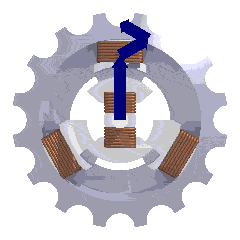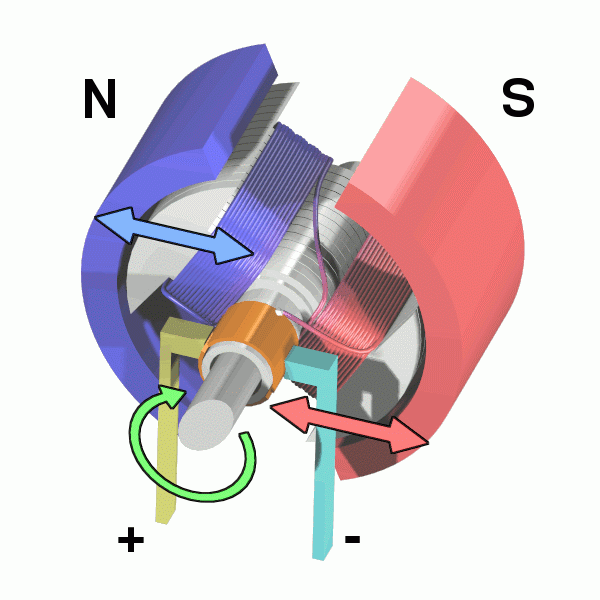The majority of industrial motors are three-phase AC induction motors due to its reliability and low cost.
In this case, the electric current in the stator winding generates a rotating magnetic field that "induces" (hence the name) electric current in the rotor. The current induced in the rotor create a magnetic field that reacts against the stator field, generating rotation in the rotor. An induction motor has to operate at a slightly lower than synchronus speed, given that rotation at synchronus speed would result in no induced rotor current.
This is why induction motors are called asynchronous, because the rotor rotates slower than the stator's rotating magnetic field to produce torque about the output shaft.
If the rotor is rotating faster than the stator's rotating magnetic field, current will be induced in the stator. In this scenario, induction motors can act as generators.
Induction motors are inexpensive because they only require electromagnets in the stator and rotor to operate. They are also reliable because they do not need commutators to transmit current to the rotor, mitigating the possibility of arcing and frictional wear.
Most industrial facilities use induction motors due to their desirable characteristics such as reliability, simplicity, and affordability.

Squirrel-Cage Induction Motor (Wikipedia)
For synchronous motors the rotation of the shaft is synchronized with the frequency of the current supplied to the motor. The stator of the motor contains electromagnets that create a magnetic field, which rotates according to the characteristics of the current applied to it. The rotor contains permanent magnets or electromagnets that react against the magnetic field generated in the rotor, generating rotation of the shaft. The rotor requires a physical connection to electric power by the means of a commutator, usually consisting a conductive brush that can wear out from use.
These motors are called synchronous because the rotor rotates at the same speed as the stator's rotating magnetic field.
Although less commonly used due to higher cost, AC synchronous motors exhibit higher power efficiency than AC induction motors.
AC synchronous motors are unique in the fact that they can be used to correct the power factor of an industrial facility.

Synchronous Motor Magnetic Field Vectors (Wikipedia)
DC motors are the least commonly used type of motor, succeeded by the advent of modern AC motors.
The stator produces a static magnetic field while the rotor produces a rotating magnetic field powered by a commutator.
As a result, the rotor's magnetic field attempts to align with the stator's magnetic field which produces torque about the output shaft.
Rather than utilizing electromagnets to produce a static magnetic field, permanent magnet DC motors use magnets to create the field. Since the magnetic field is always present regardless of the motor's power state, permanent magnet motors may attract other nearby ferromagnetic materials, creating a potential risk in an industrial setting.
Permanent magnet DC motors are also heavier and bulkier due to the use of magnets in the stator.

Animation of an Operating DC Motor (Wikipedia)